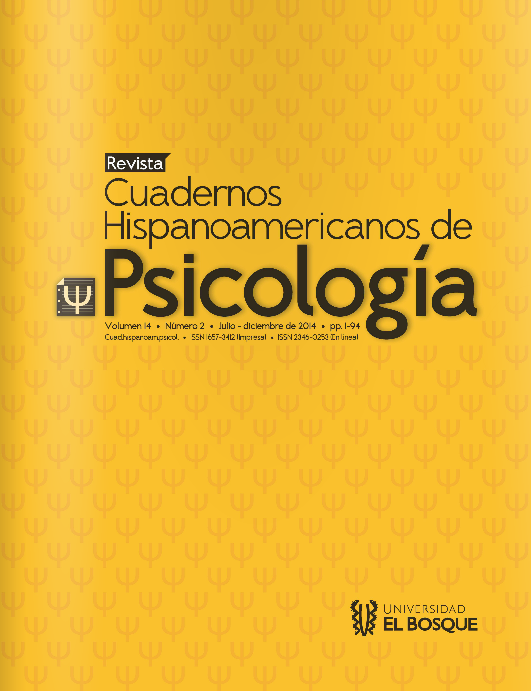La experiencia melancólica: una configuración diferencial entre la depresión mayor y la melancolía
DOI:
https://doi.org/10.18270/chps..v14i2.1334Palabras clave:
Melancolia, Melancolía, Experiencia, Experiencia, DSM-5, DSM-5, Categorías diagnósticas, Categorías diagnósticasResumen
Ante una nueva versión del DSM (DSM-5) se ha revivido la polémica en torno a la clasificación de la “melancolía” como un subtipo de la Depresión Mayor. Un grupo de psiquiatras, filósofos y psicólogos abogan por reconocerla como un desorden afectivo identificable y separable; así mismo, han planteado que es necesario reexaminar sus diferencias y afinidades con otros desórdenes como la esquizofrenia. Dentro de este marco, y a partir de una exploración fenomenoló- gica, este artículo pretende hacernos reflexionar acerca de las posibles diferencias entre las experiencias melancólicas y las de la depresión mayor. Al mismo tiempo, se observa la relación entre la melancolía y el síndrome de Cotard, síndrome que se presenta especialmente en casos de depresión severa y psicosis. Este análisis permitirá esbozar algunas razones para establecer categorías diferenciales que aclaren, entre otros aspectos, el diagnóstico y tratamiento tanto de la melancolía, como de la depresión mayor.
Descargas
Referencias bibliográficas
Aldo, N. (2007). Historia de la Depresión. La Melancolía desde la Antigüedad hasta el siglo XIX. Buenos Aires: Editorial Polemos.
American Psychiatric Association. (2000). Diagnostic and Statistical Manual of Mental Disorders (Revised 4th ed.). Washington, DC: Author.
American Psychiatric Association. (2013). Diagnostic and statistical manual of mental disorders (5th ed.). Washington, DC: Author.
Ambrosini, A., Stanghellini, G. & Langer, A. (2011). El Typus melancholicus de Tellenbach en la actualidad: una revisión sobre la personalidad premórbida vulnerable a la melancolía. Actas Esp. Psiquiatría, 39 (5), 302-311.
Blackman, L. (2010). Embodying Affect: Voice-hearing, Telepathy, Suggestion and Modelling the Non-conscious. Body & Society, 16, 163-192.
Bolwig, T. & Shorter, E. (2007). Melancholia: Beyond DSM, Beyond Neurotransmitters. Acta Psychiatr. Scand. Suppl, 115.
Brown, W. (2007). Treatment response in melancholia. Acta Psychiatr. Scand Suppl, 115,130–135.
Coryell, W. (2007). The facets of melancholia. Acta Psychiatrica Scandinavica, 115, 31–36.
Enoch, M, D. & Trethowan, W, H. (1991). Uncommon Psychiatric Syndromes. Bristol: Wright.
Ezquiaga, E., García, A., Díaz, M., & Garcia, M. (2011). “Depresión”. Imprecisión diagnóstica y terapéutica. Importantes consecuencias en la práctica clínica. Rev. Asoc. Esp. Neuropsiquíatrica, 31 (111), 457-475.
Fink, M., Bolwig, T., Parker, G & Shorter, E. (2007). Melancholia: restoration in psychiatric classification recommended. Acta Psychiatr Scand, 13 (2), 89–92.
Fink, M. & Taylor, M. (2007). Resurrecting melancholia. Acta Psychiatr Scandinavica, 433, 14-20.
Fuchs, T. (2005). Corporealized and disembodied minds: A phenomenological view of the body in melancholia and schizophrenia. Philosophy, Psychiatry & Psychology, 12, 95-107.
Fuchs, T. (2010). Phenomenology and psychopathology. En: Schmicking, D. and Gallagher, S. (eds.) Handbook of Phenomenology and Cognitive Science (pp, 547-573). Springer Science.
Jackson, S. (1983). Melancholia and Partial Insanity. Journal of the History of Behavioral Science, 19, 173–84.
Jackson, S. (1989). Historia de la melancolía y de la depresión. Londres: Ed. Turner.
Kraus, A. (2003). How can the phenomenological-anthropological approach contribute to diagnosis and classification in psychiatry? En: Fulford, B., Morris, K., Sadler, J., Stanghellini, G. (eds.) Nature and narrative. Oxford: Oxford University Press.
Mizushima, J., Sakurai, H., Mizuno, Y., Shinfuku, M., Tani, H., Yoshida, K., Ozawa, C., Serizawa, A., Kodashiro, N., Koide, S., Minamisawa, A., Mutsumoto, E., Nagai, N., Noda, S., Tachino, G., Takahashi, T., Takeuchi, H., Kikuchi, T., Uchida, H., Watanabe, K., Kocha, H. & Mimura, M. (2013). Melancholic and reactive depression: a reappraisal of old categories. BMC Psychiatry, 13, 311.
Parker, G., Fink, M., Shorter, E., Taylor, M & Akiskal, H. (2010). Issues for DSM-5: whither melancholia? The case for its classification as a distinct mood disorder. Am J Psychiatry, 13 (7), 745–747.
Perry, P. (1996). Pharmacotherapy for major depression with melancholic features: relative efficacy of tricyclic versus selective serotonin reuptake inhibitor antidepressants. Journal Affective Disorders, 39, 1–6.
Piguet, C., Dayer, A., Kosel, M., Desseilles, M., Vuilleumier, P & Bertschy, G. (2010). Phenomenology of racing and crowded thoughts in mood disorders: A theoretical reappraisal. Journal of Affective Disorders, 121, 189-198.
Radden, J. (2008). Moody Minds Distempered: Essays on Melancholy and Depression. New York: Oxford University Press.
Ratcliffe, M. (2012a). Varieties of temporal experience in depression. Journal of Medicine and Philosophy, 37, 114–138.
Ratcliffe, M. (2012b). Phenomenology as a Form of Empathy, Inquiry: An Interdisciplinary Journal of Philosophy, 55 (5), 473-495.
Rossi, M. (2012). Depression: The melancholic Truth. Psychiatry on Line. Italy.
Sass, L. & Pienkos, E. (2013a). Varieties of self experience: A comparative phenomenology of melancholia, mania, and schizophrenia, I. Journal of Consciousness Studies, 20, 103-130.
Sass, L. & Pienkos, E. (2013b). Space, time, and atmosphere: A comparative phenomenology of melancholia, mania, and schizophrenia, II. Journal of Consciousness Studies, 20, 131-152.
Silber, E., Rey, AC., Savard, R. & Post, RM. (1980). Thought disorder and affective inaccessibility in depression. Journal of Clinical Psychiatry, 41, 161-165.
Stanghellini, G. (2004). Disembodied Spirits and Deanimated Bodies. Oxford: Oxford University Press.
Tatossian, A. (1979). La phénomenologie des psychoses. Paris: Masson.
Taylor, M. & Fink, M. (2006). Melancholia: The Diagnosis, Pathophysiology and Treatment of Depressive Illness. Cambridge: Cambridge University Press.
Tellenbach, H. (1976). Melancholie. Berlin: Springer.
Varga, S. (2013). Cognition, Representations and Embodied Emotions: Investigating Cognitive Theory. USA: Spriger Media.
Varga, S. & Krueger, J. (2013). Background Emotions, Proximity and Distributed Emotion Regulation. USA: Spriger Media.
Descargas
Publicado
Cómo citar
Número
Sección















